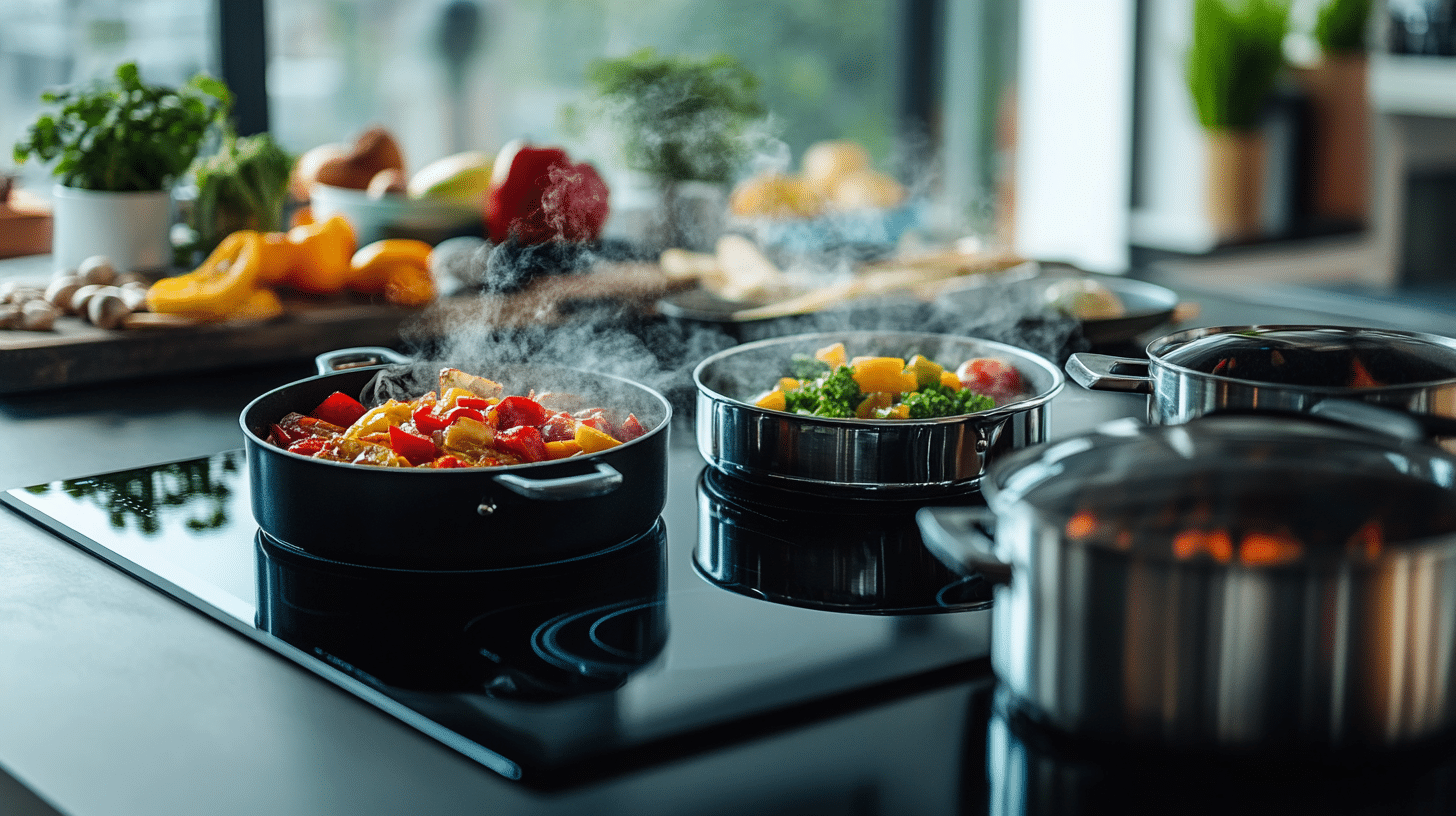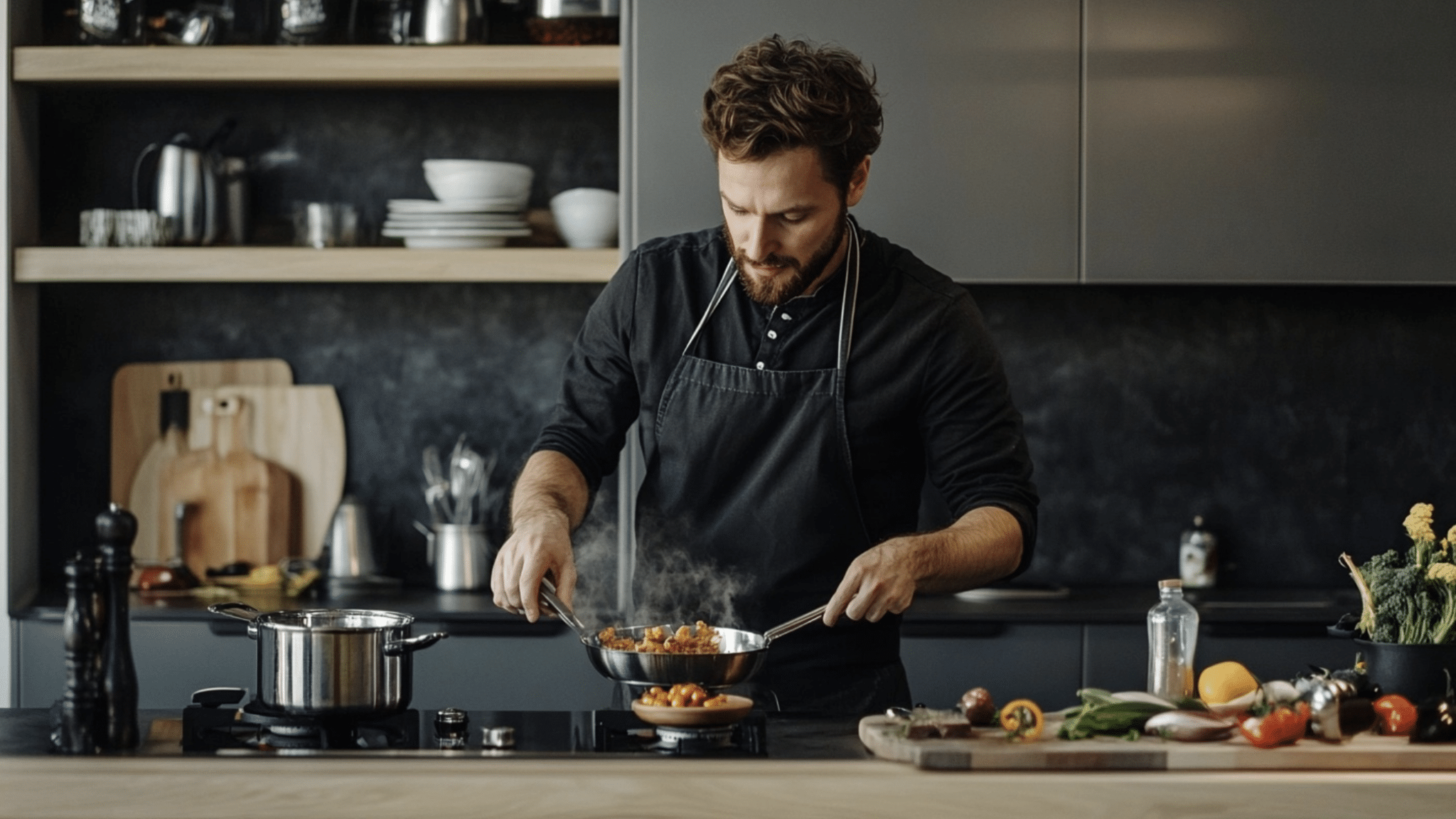
Cooking is both an art and a science, offering a variety of methods for preparing and enhancing food flavors.
From the slow, gentle braising process to the quick, intense heat of stir-frying, each cooking technique brings out unique textures and tastes.
Understanding different cooking methods can help you choose the best approach for various ingredients, ensuring that your dishes are delicious and perfectly prepared.
This blog will explore 20 cooking techniques, highlighting their key characteristics and ideal uses.
List of Different Types of Cooking

1. Baking
Baking is a dry heat cooking method often used to prepare bread, cakes, cookies, and casseroles.
It involves cooking food in an oven, allowing for even heat distribution and a crispy or firm texture.
- Heat Source: Oven
- Best For: Bread, cakes, cookies, casseroles
- Features: Even heat distribution, dry heat, crispy texture
2. Grilling
Grilling involves cooking food over direct heat, usually on a grill or barbecue.
It’s ideal for meats, vegetables, and seafood, giving them a charred, smoky flavor and a crisp exterior.
- Heat Source: Direct heat, grill
- Best For: Meats, vegetables, seafood
- Features: Charred flavor, crisp exterior, quick cooking
3. Roasting
Roasting is a dry heat cooking method similar to baking but typically used for larger cuts of meat and vegetables.
It involves cooking food in an oven at high temperatures to achieve a browned, caramelized exterior.
- Heat Source: Oven
- Best For: Meats, vegetables
- Features: High temperature, caramelized exterior, rich flavor
4. Frying
Frying involves cooking food in hot oil, giving it a crispy, golden exterior.
It can be done in a shallow pan (pan-frying) or deep fryer (deep-frying).
Frying is commonly used for foods like chicken, fish, and potatoes.
- Heat Source: Hot oil
- Best For: Chicken, fish, potatoes
- Features: Crispy exterior, golden color, quick cooking
5. Sautéing
Sautéing is a quick cooking method that uses a small amount of oil or butter in a hot pan.
It’s ideal for cooking vegetables, meats, and seafood, allowing them to brown quickly while retaining moisture.
- Heat Source: Hot pan, oil, or butter
- Best For: Vegetables, meats, seafood
- Features: Quick cooking, browning, retains moisture
6. Boiling
Boiling involves cooking food in boiling water or broth.
It’s a versatile method for pasta, vegetables, and eggs, resulting in tender and evenly cooked food.
- Heat Source: Boiling water or broth
- Best For: Pasta, vegetables, eggs
- Features: Tender texture, even cooking, versatile
7. Steaming
Steaming is a gentle cooking method that uses steam from boiling water to cook food.
It’s ideal for preserving the nutrients and flavors of vegetables, fish, and dumplings.
- Heat Source: Steam from boiling water
- Best For: Vegetables, fish, dumplings
- Features: Nutrient retention, gentle cooking, moist texture
8. Poaching
Poaching involves cooking food in a gently simmering liquid, such as water, broth, or wine.
It’s often used for delicate foods like eggs, fish, and poultry, resulting in tender, moist dishes.
- Heat Source: Simmering liquid
- Best For: Eggs, fish, poultry
- Features: Gentle cooking, tender texture, moist
9. Simmering
Simmering is a slow cooking method where food is cooked just below boiling, in water or broth.
It’s ideal for soups, stews, and sauces, allowing flavors to meld together over time.
- Heat Source: Liquid just below boiling
- Best For: Soups, stews, sauces
- Features: Slow cooking, flavor melding, gentle heat
10. Blanching
Blanching involves briefly boiling food, usually vegetables, and plunging it into ice water to stop cooking.
This technique is often used to preserve color, texture, and nutrients before freezing or further cooking.
- Heat Source: Boiling water, ice water
- Best For: Vegetables
- Features: Preserves color and texture, quick cooking, nutrient retention
11. Broiling
Broiling is a high-heat cooking method where food is cooked directly under a heat source, usually in an oven.
It’s great for quickly cooking thin cuts of meat, fish, or vegetables, giving them a caramelized exterior.
- Heat Source: Direct heat, oven
- Best For: Thin cuts of meat, fish, vegetables
- Features: High heat, caramelized exterior, quick cooking
12. Braising
Braising involves slow-cooking food in a small amount of liquid, often after browning it.
It’s used for tougher cuts of meat and hearty vegetables, resulting in tender, flavorful dishes.
- Heat Source: Low heat, liquid
- Best For: Tough cuts of meat, vegetables
- Features: Slow cooking, tender texture, rich flavor
13. Stewing
Stewing is similar to braising but involves fully submerging food in liquid.
This slow-cooking method is perfect for creating rich, hearty dishes like beef or vegetable stew.
- Heat Source: Low heat, liquid
- Best For: Meats, vegetables
- Features: Slow cooking, rich flavor, hearty dishes
14. Smoking
Smoking is cooking food by exposing it to smoke from burning wood.
It’s often used for meats, fish, and cheeses, imparting a rich, smoky flavor and preserving the food.
- Heat Source: Smoke from burning wood
- Best For: Meats, fish, cheese
- Features: Smoky flavor, slow cooking, preservation
15. Sous Vide
Sous vide involves vacuum-sealing food in a bag and cooking it in a water bath at a precise, low temperature.
This method ensures even cooking and retains moisture and flavor, making it ideal for meats and vegetables.
- Heat Source: Water bath, low temperature
- Best For: Meats, vegetables
- Features: Precise cooking, moisture retention, tender texture
16. Slow Cooking
Slow cooking involves cooking food at a low temperature for an extended period, usually in a slow cooker.
It’s ideal for stews, roasts, and soups, allowing flavors to develop deeply.
- Heat Source: Slow cooker, low temperature
- Best For: Stews, roasts, soups
- Features: Extended cooking time, deep flavors, tender results
17. Pressure Cooking
Pressure cooking uses high pressure and steam to cook food quickly.
It’s great for tenderizing tough cuts of meat and speeding up cooking times for grains and beans.
- Heat Source: Steam, high pressure
- Best For: Meats, grains, beans
- Features: Quick cooking, tender results, energy-efficient
18. Stir-Frying
Stir-frying involves cooking food quickly in a small amount of oil over high heat, usually in a wok.
It’s ideal for vegetables, meats, and tofu, preserving their color, texture, and nutrients.
- Heat Source: High heat, wok
- Best For: Vegetables, meats, tofu
- Features: Quick cooking, vibrant color, nutrient retention
19. Microwaving
Microwaving uses microwave radiation to heat and cook food quickly.
It’s convenient for reheating leftovers, cooking frozen meals, and steaming vegetables.
- Heat Source: Microwave radiation
- Best For: Reheating, frozen meals, vegetables
- Features: Quick, convenient, versatile
20. Deep-Frying
Deep-frying involves cooking food by fully submerging it in hot oil.
This method creates a crispy, golden exterior and is commonly used for foods like fries, chicken, and doughnuts.
- Heat Source: Hot oil
- Best For: Fries, chicken, doughnuts
- Features: Crispy exterior, golden color, rich flavor
Conclusion
Understanding different cooking methods can greatly enhance your culinary skills, allowing you to create various dishes with the perfect texture and flavor.
Whether simmering a hearty stew or quickly stir-frying vegetables, each technique offers something unique to your cooking repertoire.
By mastering these 20 types of cooking, you can confidently prepare meals that are not only delicious but also showcase your culinary expertise.

